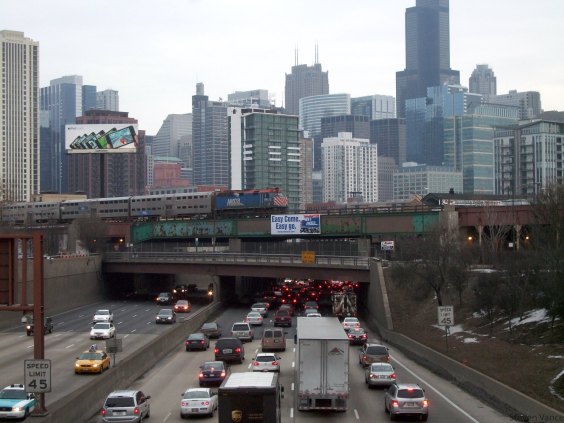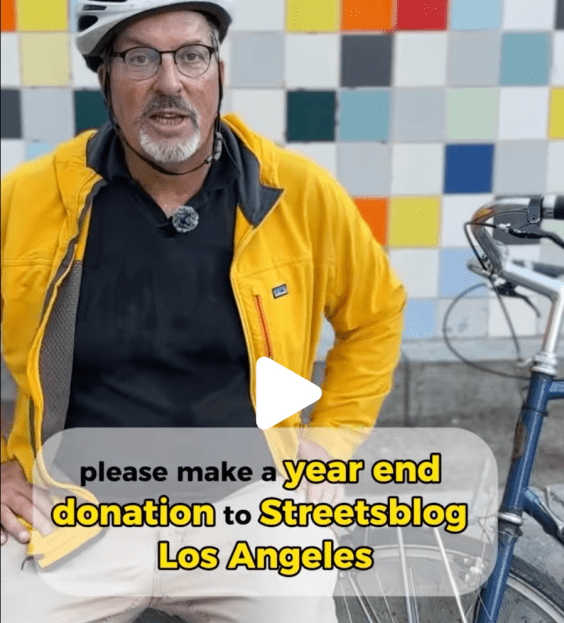Editor's note: This piece was written for Shaping San Francisco and is now incorporated into the new wiki version, your best place to research San Francisco history, FoundSF.org.
 Protesters march along Embarcadero in early 1960s, stump of Embarcadero Freeway ends behind them at Broadway.
Protesters march along Embarcadero in early 1960s, stump of Embarcadero Freeway ends behind them at Broadway. Photo courtesy San Francisco History Center, SF Public Library
In the 1950s, the California Division of Highways had a plan to extend
freeways across San Francisco. At that time the freeway reigned supreme
in California, but San Francisco harbored the seeds of an incipient
revolt which ultimately saved several neighborhoods from the wrecking
ball and also put up the first serious opposition to the post-WWII
consensus on automobiles, freeways, and suburbanization.
 Early plan for 8-lane freeway to cut under Russian Hill on its way from the Embarcadero to the Golden Gate Bridge.
Early plan for 8-lane freeway to cut under Russian Hill on its way from the Embarcadero to the Golden Gate Bridge.The Haight-Ashbury Neighborhood Council (HANC), one of the city's
oldest and most persistent neighborhood groups, dates its origins to
the initial struggles against the proposed Panhandle-Golden Gate Park
freeway, which was to extend the central freeway up the Oak/Fell
corridor, slice 60% of the Panhandle for the roadway, and tunnel under
the north edge of Golden Gate Park before turning onto today's Park
Presidio towards the Golden Gate Bridge.
On November 2, 1956 the San Francisco Chronicle
graciously published a map of the proposed and actual freeway routes
through San Francisco even though its accompanying editorial was
already chastising protestors: "The remarkable aspect of these protests
and claims of injury is their tardiness. They concern projects that
have for years been set forth in master plans, surveys and expensive
traffic studies. They have been ignored or overlooked by citizens and
public official alike—until the time was at hand for concrete pouring
and when revision had become either impossible or extremely costly. The
evidence indicates that the citizenry never did know or had forgotten
what freeways the planners had in mind for them."
 In the 1940s the California Dept. of Highways came up with
In the 1940s the California Dept. of Highways came up withvarious plans to blanket San Francisco with freeways. This is a version
proposed in 1948 by San Francisco's Planning Department. Image: San Francisco Planning and Urban Research (SPUR)
Just three years earlier San Francisco had opened what became known as "hospital curve"
both for its location behind General Hospital and its high rate of
accidents. On October 1, 1953 the Bayshore Freeway opened from Army to
Bryant/7th Street, nearing a later direct link with the Bay Bridge. San
Franciscans could now drive three unmolested miles of "divided no-stop
freeways" from Alemany to Bryant. But as the plans unfolded, public
opposition grew. By the time the Embarcadero Freeway was nearly under
construction in 1958, a loud opposition had formed, going on to
campaign for its removal after its completion. Over 30,000 people
signed petitions at meetings organized in the Sunset, Telegraph and
Russian Hills, Potrero, Polk Gulch and other threatened areas. In 1959
The Supervisors voted to cancel 7 of 10 planned freeway routes through
the city, much to the shock of the Department of Highways and the state
government. But that was not the end of the freeway revolt.
 James Lick Freeway under construction in 1953: San Francisco's first. Seals Stadium, the old ballpark is visible in center-left of photo. Photo: Ed Brady
James Lick Freeway under construction in 1953: San Francisco's first. Seals Stadium, the old ballpark is visible in center-left of photo. Photo: Ed Brady  Proposed freeway routes for the continuation of the Embarcadero Freeway to the Golden Gate Bridge.
Proposed freeway routes for the continuation of the Embarcadero Freeway to the Golden Gate Bridge.Freeway builders continued to resurrect various routes,
encountering persistent, well-organized resistance by San Francisco
neighborhoods. In 1964 the Panhandle-Golden Gate Freeway plan reached a
climax, with a May 17 rally at the Polo Grounds to save the Park,
featuring a "Natural Anthem" and a dedicated tune by Malvina Reynolds,
the famous left-wing folk singer, and a speech by poet Kenneth Rexroth.
Months later, in a final, climactic 6-5 vote, the Board of Supervisors
rejected the Park Freeway on October 13. Black supervisor Terry
Francois cast the deciding vote, delivering a point-by-point six-page
rebuttal to the pro-freeway arguments. (It is interesting to note that
the other No-votes on that Board were future mayor George Moscone,
future CAO/auto dealer and consumer of sexual services Roger Boas,
future Lt. Governor Leo McCarthy, William Blake and Clarissa McMahon.
In favor of the freeway were "progressive" supervisors Jack Morrison,
Joseph Casey, Jack Ertola, Joseph Tinney and Peter Tamaras.) Mayor Jack
Shelley was all for it, as was the Labor Council from which he hailed.
The Supervisors' Transportation Committee had received a petition with
15,000 signatures, 20,000 letters and telegrams, and had received
opposition from 77 community organizations.
Today, San Francisco's freeways have changed again, thanks to
the Loma Prieta 1989 earthquake. The much maligned Embarcadero Freeway
has been removed, as has an unsightly spur of the Central Freeway. A
raging debate over the future of the Central Freeway ramps that go
north across Market was finally resolved and has now been replaced by
the surface Octavia Boulevard. The 101-280 interchange was a mess from
1989 to 1996. New offramps were added to I-280 to serve a new
waterfront roadway and the planned Giants ballpark at China Basin in
1997, but no new freeways will be built in San Francisco. New transit
money goes to BART and MUNI, while Caltrans and SF Dept. of Public
Works continue to spend vast quantities of social wealth on maintaining
the San Francisco road system. The rapid rise in value in both areas
where freeways were removed, along the now open waterfront, as well as
the rapidly gentrifying Hayes Valley/Civic Center area, show that
profits can be drawn from forward looking urban planning,
de-emphasizing cars and re-emphasizing neighborhood, community, and
nature. But most U.S. urban planners still adhere religiously to the
cult of the car, hence constant efforts to expand roads and parking at
the expense of numerous more sensible alternatives, from decent mass
transit to ubiquitous bikeways.
 Demolition of Central Freeway over Market Street, 2003. Photo by Chris Carlsson
Demolition of Central Freeway over Market Street, 2003. Photo by Chris Carlsson Various freeway plans over the years.
Various freeway plans over the years.Maps and photos of San Francisco's original freeway plans
Images and maps of many San Francisco freeways that were never built and some that were





